![]()
![]()
![]()
Use LEFT and RIGHT arrow keys to navigate between flashcards;
Use UP and DOWN arrow keys to flip the card;
H to show hint;
A reads text to speech;
77 Cards in this Set
- Front
- Back
|
Sulfonamide
-how does it cause kernicterus |
Kernicterus is a rare neurological condition that occurs in some newborns with severe jaundice. Kernicterus is caused by very high levels of bilirubin.
Sulfonamides [suhl-fon-uh-mahyd, -mid, suhl-fuh-nam-ahyd, -id]-->bind with the albumin releasing the Bilirubin. Both use the same receptor site in albumin. In children the glucoronidation system is not matured to metabolize Bilirubin. NAT2 polymorphism can affect its toxicity. |
|
|
Thiopental
-use -mechanism of elimination -vs. metabolic acidosis |
a rapid-onset short-acting barbiturate general anesthetic
-redistribution is the mechanism of drug elimination for this highly lipophylic drug. Thiopental is weak acid. Nonionized form cross BBB. metabolic acidosis increase plasma H+ thus increase HA so more thiopental cross BBB and increase depth of the anesthesia |
|
|
chloramphenicol
-use -type of metabolic rx -gray baby syndrome |
Chloramphenicol (INN) is a bacteriostatic antimicrobial that became available in 1949. a prototypical broad-spectrum antibiotic, alongside the tetracyclines
metabolized through nitroreduction can induce gray baby syndrome |
|
|
Procaine:
-use -type of metabolic rx |
Procaine is a local anesthetic drug of the amino ester group. It was used primarily to reduce the pain of intramuscular injection of penicillin, and it was also used in dentistry.
metabolized through ester hydrolysis |
|
|
Succinycholine
-use -type of metabolic rx polymorphism |
Succinylcholine, is a nicotinic acetylcholine receptor agonist, used to induce muscle relaxation and short-term paralysis, usually to facilitate tracheal intubation.
Serum cholinesterase polymorphism Reduced ability to hydrolyze succinylcholine-->prolonged exposure may lead to death. Not hydrolyzed by AChE but is hydrolyzed by BChE. Depolarizing blockade. short during. metabolized by ester hydrolysis |
|
|
procainamide
-use -type of metabolic rx |
Procainamide INN (pron.: /proʊˈkeɪnəmaɪd/; trade names Pronestyl, Procan, Procanbid) is a pharmaceutical antiarrhythmic agent used for the medical treatment of cardiac arrhythmias.
Metabolized through amide hydrolysis NAT2 polymorphism can affect its toxicity. |
|
|
Lidocaine
-use -type of metabolic rx |
aine (INN) (pron.: /ˈlaɪdɵkeɪn/), xylocaine, or lignocaine (former BAN) (pron.: /ˈlɪɡnɵkeɪn/) is a common local anesthetic and antiarrhythmic drug. Lidocaine is used topically to relieve itching, burning and pain from skin inflammations, injected as a dental anesthetic or as a local anesthetic for minor surgery.
metabolized by amide hydrolysis |
|
|
Cimetidine
-use -drug drug interaction |
Cimetidine INN (pron.: /sɨˈmɛtɨdiːn/ or /saɪˈmɛtɨdiːn/) is a histamine H2-receptor antagonist that inhibits stomach acid production. It is largely used in the treatment of heartburn and peptic ulcers.
Cimetidine is a known inhibitor of many isozymes of the cytochrome P450 enzyme system. This inhibition forms the basis of the numerous drug interactions that occur between cimetidine and other drugs. For example, cimetidine may decrease metabolism of some drugs, such as those used in hormonal contraception. Cimetidine interferes with metabolism of the hormone estrogen, enhancing estrogen activity |
|
|
Azole antifungal drugs: eg. ketoconazole
-drug drug interaction mechanism |
For example, the azole antifungals such as ketoconazole or itraconazole can be both substrates and inhibitors of the P-glycoprotein, which (among other functions) excretes toxins and drugs into the intestines.Azole antifungals also are both substrates and inhibitors of the cytochrome P450 family CYP3A4, causing increased concentration when administering, for example, calcium channel blockers, immunosuppressants, chemotherapeutic drugs, benzodiazepines, tricyclic antidepressants, macrolides and SSRIs.
|
|
|
Macrolide antibotics: eg. erythromycine
-drug drug interaction mechanism |
It may also alter the effectiveness of combined oral contraceptive pills because of its effect on the gut flora. Erythromycin is an inhibitor of the cytochrome P450 system, which means that it can have a rapid effect on levels of other drugs metabolised by this system, e.g., warfarin.
|
|
|
Barbiturates
use induction of drug metabolism |
Barbiturates are drugs that act as central nervous system depressants, and can therefore produce a wide spectrum of effects, from mild sedation to total anesthesia
Barbiturate are classical and broad inducers |
|
|
acetaminophen
-toxicity mechanism -antidote |
Glutathione conjugation usually first defense: In the case of N-acetyl-p-benzoquinone imine (NAPQI), the reactive cytochrome P450-reactive metabolite formed by paracetamol (or acetaminophen as it is known in the US), which becomes toxic when GSH is depleted by an overdose of acetaminophen, glutathione is an essential antidote to overdose. Glutathione conjugates to NAPQI and helps to detoxify it. In this capacity, it protects cellular protein thiol groups, which would otherwise become covalently modified; when all GSH has been spent, NAPQI begins to react with the cellular proteins, killing the cells in the process
The preferred treatment for an overdose of this painkiller is the administration (usually in atomized form) of N-acetyl-L-cysteine (often as a preparation called Mucomyst[20]), which is processed by cells to L-cysteine and used in the de novo synthesis of GSH. |
|
|
Probenecid
-use -drug drug rx concern secretion -type of secretion |
Probenecid (Lannett's Probalan) is a uricosuric drug that increases uric acid excretion in the urine. It is primarily used in treating gout and hyperuricemia.
depress renal excretion of other weak acids like penicillin and phenobarbital through active tubular secretion |
|
|
sulfinpyrazone
-use mechanism - |
Sulfinpyrazone is a uricosuric medication used to treat gout, that increases uric acid excretion in the urine.
Like other uricosurics, sulfinpyrazone works by competitively inhibiting uric acid reabsorption in the proximal tubule of the kidney. |
|
|
Phenobarbital
-use -how does it excreted -does probenecid increase/decrease the excretion? |
Phenobarbital is indicated in the treatment of all types of seizures except absence seizures.
weak acid and ionized from is excreted. Alkaline urine increase excretion |
|
|
amphetamine
-use -how does it excreted. -does probenecid increase/decrease the excretion? |
It is a psychostimulant drug that produces increased wakefulness and focus in association with decreased fatigue and appetite
weak base and ionized from is excreted. acidic urine increase the excretion. |
|
|
Isoproterenol
-use -desensitization |
used for the treatment of bradycardia (slow heart rate), heart block, and rarely for asthma. It is a non-selective beta-adrenergic agonist and structurally similar to adrenaline.
Polymorphisms in beta-2 adrenergic receptor gene (ADRB2) affect response to bronchodilators such as albuterol and isoproterenol down regulate the receptor if chronic used |
|
|
propranolol
-use -super-sensitization |
a sympatholytic non-selective beta blocker[antagonist]. Sympatholytics are used to treat hypertension, anxiety and panic. It was the first successful beta blocker developed.
chronic use can cause supersensitization b/c up-regulate the receptors |
|
|
Atropine
-type of antagonist -use |
cholinergic competitive antagonist , reversible, surmountable, muscarinic receptor blocker. Get rid of all parasympathetic effect.
It is a competitive antagonist for the muscarinic acetylcholine receptor. It is classified as an anticholinergic drug (parasympatholytic). Working as a nonselective muscarinic acetylcholinergic antagonist, atropine increases firing of the sinoatrial node (SA) and conduction through the atrioventricular node (AV) of the heart, opposes the actions of the vagus nerve, blocks acetylcholine receptor sites, and decreases bronchial secretions. |
|
|
Phenoxybenzamine
-type of antagonist -use |
a non-selective, irreversible competitive alpha adrenergic antagonist. non-equilibrium, insurmountable.
used in the treatment of hypertension, and specifically that caused by pheochromocytoma. It has a slower onset and a longer lasting effect compared with other alpha blockers. |
|
|
diazoxide
-type of antagonists |
Diazoxide is antihypertensive via dilation of arterioles; non- competitive inhibitor of norepinephrine
|
|
|
neostigmine
-vs succinylcholine |
Neostigmine (Prostigmin, Vagostigmin) is a parasympathomimetic that acts as a reversible acetylcholinesterase inhibitor.
potentiation drug drug interaction with succinylcholine |
|
|
Succinylcholine
-vs neotigmine |
is a nicotinic acetylcholine receptor agonist, used to induce muscle relaxation and short-term paralysis, usually to facilitate tracheal intubation.
potentiation drug drug interaction with neostigmine. |
|
|
Mercaptopurine
|
(also called 6-mercaptopurine, 6-MP or its brand name Purinethol) is an immunosuppressive drug.
It is a thiopurine. It is used to treat leukemia, pediatric non-Hodgkin's lymphoma, polycythemia vera, psoriatic arthritis and inflammatory bowel disease (such as Crohn's disease and ulcerative colitis). Thiopurine-S-Methyltransferase (TMPT) Polymorphism. TMPT deactive this drug. |
|
|
irinotecan
|
Irinotecan (Camptosar, Pfizer; Campto, Yakult Honsha) is a drug used for the treatment of cancer.
Irinotecan prevents DNA from unwinding by inhibition of topoisomerase 1 FDA ave explicit recommendations for using pharmacogenetic information to improve drug efficacy/safety UGT polymorphism is associated with increased toxicity (myelosuppression and diarrhea) following use of irinotecan. [UGT catalyze the Glucuronidation, the addition of glucuronic acid to a substrate] |
|
|
tamoxifen
|
Tamoxifen is an antagonist of the estrogen receptor in breast tissue via its active metabolite, hydroxytamoxifen. In other tissues such as the endometrium, it behaves as an agonist, and thus may be characterized as a mixed agonist/antagonist. Tamoxifen is the usual endocrine (anti-estrogen) therapy for hormone receptor-positive breast cancer
FDA ave explicit recommendations for using pharmacogenetic information to improve drug efficacy/safety. Tamoxifen is biotransformed to the potent anti-estrogen, endoxifen, by CYP2D6. CYP2D6 polymorphism has poor outcome in tx of breast cancer. |
|
|
Abacavir
|
Abacavir (ABC) i/ʌ.bæk.ʌ.vɪər/ is a nucleoside analog reverse transcriptase inhibitor (NRTI) used to treat HIV and AIDS
FDA ave explicit recommendations for using pharmacogenetic information to improve drug efficacy/safety. HLA-B polymorphism may lead to severe hypersensitivity. |
|
|
Clopidogrel
|
Clopidogrel (INN) is an oral, thienopyridine class antiplatelet agent used to inhibit blood clots in coronary artery disease, peripheral vascular disease, and cerebrovascular disease. It is under the trade name Plavix. The drug works by irreversibly inhibiting a receptor called P2Y12, an adenosine diphosphate (ADP) chemoreceptor on platelet cell membranes. Adverse effects include hemorrhage, severe neutropenia, and thrombotic thrombocytopenic purpura (TTP).
FDA ave explicit recommendations for using pharmacogenetic information to improve drug efficacy/safety. CYP2C19 biotransforms many clinically useful drugs including clopidogrel. CYP2C19 polymorphism may cause tx failure. |
|
|
Trastuzumab
|
Trastuzumab (INN; trade names Herclon, Herceptin) is a monoclonal antibody that interferes with the HER2/neu receptor. Its main use is to treat certain breast cancers.
FDA ave explicit recommendations for using pharmacogenetic information to improve drug efficacy/safety |
|
|
Isoniazid
|
soniazid (Laniazid, Nydrazid) is an organic compound that is the first-line medication in prevention and treatment of tuberculosis.
NAT2 polymorphism can affect its toxicity. |
|
|
Hydralazine
|
Hydralazine (apresoline) is a direct-acting smooth muscle relaxant used to treat hypertension by acting as a vasodilator primarily in arteries and arterioles.
NAT2 polymorphism can affect its toxicity. |
|
|
Amonafide
|
Amonafide (originally AS1413) (INN, trade name Quinamed) is a drug that is being studied in the treatment of cancer. It belongs to the families of drugs called topoisomerase inhibitors and DNA intercalators.
NAT2 polymorphism can lead to rapid acetylators..myelosuppression[=bone marrow suppression] |
|
|
Azathioprine
|
Azathioprine (INN, pron.: /ˌæzəˈθaɪɵpriːn/, abbreviated AZA) is an immunosuppressive drug used in organ transplantation and autoimmune diseases and belongs to the chemical class of purine analogues.
Thiopurine-S-Methyltransferase (TMPT) Polymorphism. TMPT eactive this drug. |
|
|
Phenacetin
|
Phenacetin is an analgesic, once widely used; its use has declined because of its adverse effects.
CYP2D6 polymorphism poor metabolite phenotype my lead to more toxic pathway. |
|
|
Phenytoin
|
Phenytoin sodium (/fəˈnɪtoʊɨn/) is a commonly used antiepileptic. Phenytoin acts to suppress the abnormal brain activity seen in seizure
CYP2C9 oxidize this drug |
|
|
Sulfonylurea
|
Sulfonylurea (UK: sulphonylurea) derivatives are a class of antidiabetic drugs that are used in the management of diabetes mellitus type 2. They act by increasing insulin release from the beta cells in the pancreas.
CYP2C9 oxidize this drug |
|
|
Warfarin
|
Warfarin (also known under the brand names Coumadin) is an anticoagulant normally used in the prevention of thrombosis and thromboembolism, the formation of blood clots in the blood vessels and their migration elsewhere in the body respectively.
CYP2C9 oxidize this drug |
|
|
albuterol
|
Salbutamol (INN) or albuterol (USAN) is a short-acting β2-adrenergic receptor agonist used for the relief of bronchospasm in conditions such as asthma and chronic obstructive pulmonary disease.
Polymorphisms in beta-2adrenergic receptor gene (ADRB2) affect response to bronchodilators such as albuterol and isoproterenol |
|

Dopa pathway
|
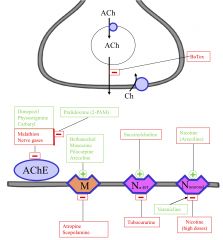
Ach pathway
|
|
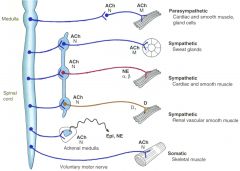
PNS neuro transmitter
|

table
|
|
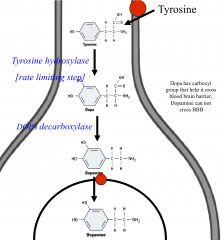
Dopa
|
L-DOPA is the precursor to the neurotransmitters dopamine, norepinephrine (noradrenaline), and epinephrine (adrenaline) collectively known as catecholamines. As a drug it is used in the clinical treatment of Parkinson's disease and dopamine-responsive dystonia.
|
|
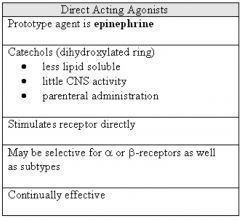
epinephrine vs amphetamine
|
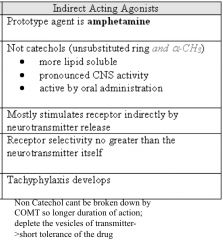
amphetamine is a psychostimulant drug of the phenethylamine class that produces increased wakefulness and focus in association with decreased fatigue and appetite.
Epinephrine (also known as adrenaline or adrenalin) is a hormone and a neurotransmitter. Epinephrine has many functions in the body, regulating heart rate, blood vessel and air passage diameters, and metabolic shifts; epinephrine release is a crucial component of the fight-or-flight response of the sympathetic nervous system |
|
|
adrenergic agonists vs receptor selectivity
phenylephrine norepinephine epinephrine ephedrine pseudoephedrine dopamine [amphetamine] [methamphetamine] [Methyphenidate] Isoproterenol Albuterol |
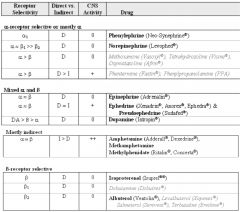
-Phenylephrine is a selective α1-adrenergic receptor agonist used primarily as a decongestant, as an agent to dilate the pupil, and to increase blood pressure
-Ephedrine is a sympathomimetic amine commonly used as a stimulant, appetite suppressant, concentration aid, decongestant, and to treat hypotension associated with anaesthesia. -Pseudoephedrine is a sympathomimetic drug . It may be used as a nasal/sinus decongestant, as a stimulant, or as a wakefulness-promoting agent. -Amphetamine is a psychostimulant drug that produces increased wakefulness and focus in association with decreased fatigue and appetite. -Methamphetamine in treating ADHD and exogenous obesity (obesity originating from factors outside of the patient's control) in both adults and children. -Methylphenidate is a psychostimulant drug approved for treatment of ADHD or attention-deficit hyperactivity disorder. -Isoprenaline or isoproterenol is a medication used for the treatment of bradycardia (slow heart rate), heart block, and rarely for asthma. It is a non-selective beta-adrenergic agonist and structurally similar to adrenaline. -albuterol is a short-acting β2-adrenergic receptor agonist used for the relief of bronchospasm in conditions such as asthma and chronic obstructive pulmonary disease |
|
|
effect of alpha/beta receptor adrenergic drug on
-cardiovascular system (PVR, CO,BP) -Eye (Radial, ciliary) -GI -Bladder -Urinary sphincter -Bronchioles |
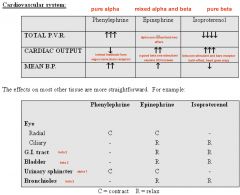
|
|
|
adrenergic antagonist drugs
-Phentoloamine -Tamsulosis -Propran-olol |
![Phentolamine (Regitine) is a reversible[1] nonselective alpha-adrenergic antagonist.The primary application for phentolamine is for the control of hypertensive emergencies, most notably due to pheochromocytoma
Tamsulosin (pron.: /tæmˈsuːlɵsɨn/ or /tæm](https://images.cram.com/images/upload-flashcards/101484/572795_m.jpg)
Phentolamine is a reversible nonselective alpha-adrenergic antagonist.The primary application for phentolamine is for the control of hypertensive emergencies, most notably due to pheochromocytoma
Tamsulosin (pron.: /tæmˈsuːlɵsɨn/ or /tæmsʉˈloʊsɨn/) is a treatment for difficult urination, a common symptom of enlarged prostate. Propranolol is a sympatholytic non-selective beta blocker. Sympatholytics are used to treat hypertension(beta 1), anxiety and panic. It was the first successful beta blocker developed. |
|
|
Other adrenergic drugs:
-Dopa drugs Carbidopa Levodopa (L-Dopa) -Reuptake blockers antidepressants Cocaine -MAO inhibitors |
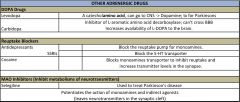
Carbidopa (Lodosyn) is a drug given to people with Parkinson's disease in order to inhibit peripheral metabolism of levodopa. This property is significant in that it allows a greater proportion of peripheral levodopa to cross the blood brain barrier for central nervous system effect.
|
|
|
Bethanechol
|
1. Choline Esters
2. Bethanechol is a parasympathomimetic choline carbamate that selectively stimulates muscarinic receptors without any effect on nicotinic receptors. Unlike acetylcholine, bethanechol is not hydrolyzed by cholinesterase and will therefore have a long duration of action. 3. Bethanechol is sometimes given orally or subcutaneously to treat urinary retention resulting from general anesthetic or diabetic neuropathy of the bladder, or to treat gastrointestinal atony (lack of muscular tone). The muscarinic receptors in the bladder and gastrointestinal tract stimulate contraction of the bladder and expulsion of urine, and increased gastrointestinal motility, respectively |
|
|
what type of drugs are these? use?
a.Muscarine b.Pilocarpine c.Arecoline |
1. cholinergic alkaloids.
a. nature produce from mushroom, can not be hydrolyzed by AChE b.Pilocarpine is a parasympathomimetic alkaloid. It is a non-selective muscarinic receptor agonist in the parasympathetic nervous system, which acts therapeutically at the muscarinic acetylcholine receptor M3 due to its topical application, e.g., in glaucoma and xerostomia. c. Arecoline is a natural product, an alkaloid found in Betel nut [like chewing cigarette] |
|
|
what type of these inhibitor are these:
1. Edrophonium 2. Donepezil 3. Physostigmine 4. Malathion and nerve gases[VX, Sarin] |
They are Cholinesterase Inhibitors
1.Short-acting competitive inhibitor [Edrophonium mainly for diagnostic purpose] 2.Noncompetitive inhibitors Donepezil used in the palliative treatment of mild to moderate Alzheimer's disease. Common side effects include gastrointestinal upset. It has an oral bioavailability of 100% and easily crosses the blood–brain barrier. Because it has a half-life of about 70 hours, it can be taken once a day. 3. Carbamates (intermediate duration) Physostigmine is used to treat myasthenia gravis, glaucoma, Alzheimer's disease and delayed gastric emptying. It has been shown to improve short term memory (CNS activity). Because it is a tertiary amine (and thus does not hydrogen bond, making it more hydrophobic), it can cross the blood–brain barrier, and physostigmine salicylate is used to treat the central nervous system effects of atropine, scopolamine and other anticholinergic drug overdoses. 4. Organophosphates (long duration – irreversible) Malathion binds irreversibly to cholinesterase. Malathion is an insecticide of relatively low human toxicity |
|
|
Pralidoxime (2-PA)
|
Cholinesterase reactivator!!
“Rips” the organophospate inhibitor off the ChE enzyme Most effective within hours of exposure to ChE inhibitor. Before the substrate-enzyme bond stabilize itself. It is used to combat poisoning by organophosphates or acetylcholinesterase inhibitors (nerve agents) in conjunction with atropine and diazepam. |
|
|
Scopolamine
|
Scopolamine, also known as levo-duboisine and hyoscine, is a tropane alkaloid drug with muscarinic antagonist effects.
Its primary use is for the treatment of post-operative nausea and vomiting, sea-sickness, OTC sleeping pills, |
|
|
four psycho CNS stimulator, how do they work?
|
1. amphetamine: get into brain and release dopamine to pleasure center
2. cocaine: blocking re-uptake of dopamine 3. nicotine: stimulator excitatory receptors. hippocampus improve function 4. Caffeine: Adenosine acts as an inhibitor neurotransmitter that suppresses activity in the central nervous system. Consumption of caffeine antagonizes adenosine and increases activity in neurotransmission including acetylcholine, epinephrine, dopamine, serotonin, glutamate, norepinephrine, cortisol, |
|
|
Tubocurarine
|
Nondepolarizing Ach antagonists
no intial stimulatiion, competitive nondeporlarizing blockade only ChE inhibitor reverses blockade Tubocurarine is a skeletal muscle relaxant in the category of non-depolarizing neuromuscular-blocking drugs, used adjunctively in anesthesia to provide skeletal muscle relaxation during surgery or mechanical ventilation. |
|
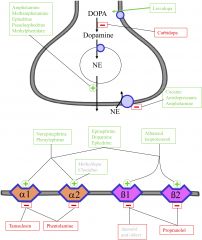
Adrenergic Drugs summary
Green are agonists. Red are antagonists. |
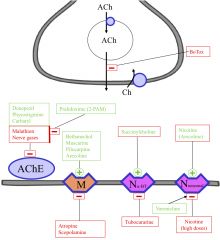
cholinergic drugs summary
Green are agonists. Red are antagonists. |
|
|
Heparin [UFH-generic]
|
antithrombin dependent anticoagulant that inhibit proteases, especially factors IIa and Xa
large molecule, nonspecific must be given parenterally b/c not absorbed from GI short half life and cleared by endothelial cells, reticuloendothelial cells which can get saturated thus non linear dose increase effect. |
|
|
Enoxaparin
|
Enoxaparin is a low molecular weight heparin. It is an anticoagulant used to prevent and treat deep vein thrombosis or pulmonary embolism, and is given as a subcutaneous injection. Its use is evolving in acute coronary syndromes (ACS).
cleared primary by kidney. Advantages vs Heparin: more predictable response; better bioavailability; longer half life; dose independent clearance; w/o lab monitoring; outpatient use possible. |
|
|
Fondaparinux
|
Fondaparinux is an anticoagulant medication chemically related to low molecular weight heparins. It is a synthetic pentasaccharide Factor Xa inhibitor. primarily eliminated by the kidney and require antithrombin like heparin
|
|
|
Protamine
|
Protamine sulfate is an antidote for heparin overdose. A chain shortened version of protamine also acts as a potent heparin antagonist. It has positive charge that can attract negative charged UFH.
|
|
|
Argatroban
|
Argatroban is an anticoagulant that is a small molecule direct thrombin inhibitor.Do not require antithrombin. inhibit free and clot-bound thrombin.
Indication: pts with HIT or risk of HIT under percutaneous coronary intervention. No antidote! |
|
|
Desirudin
|
recombinant derivative of the irreversible thrombin inhibitor hirudin.
indication: DVT, PE No antidote! |
|
|
Bivalirudin
|
Synthetic 20 aa reversible thrombin inhibitors from hirudin
indication: used with aspirin and GPI with PCI/ PTCA No antidote! |
|
|
Warfarin
|

Vitamin K antagonist. block Vitamin K oxide reductase. non irreversible Vit K competetive inhibitor. slow onset and slow elimination
Warfarin (also known under the brand names Coumadin) is an anticoagulant normally used in the prevention of thrombosis and thromboembolism. Dose requrie adjust b/c diet, liver disease and medication. Warfarin crosses placenta, so do not give warfarin to pregnant wemon, especiall 1st trimesters. |
|
|
Dabigatran Etexilate
|
Dabigatran is an oral anticoagulant from the class of the direct thrombin inhibitors, no antidote.
prevent clot forming and prevent already formed clot getting bigger, but can not chew up already formed drug. no food restriction. |
|
|
Rivaroxaban
|
Rivaroxaban is an oral anticoagulant . reversible factor Xa inhibitor.
|
|
|
Alteplase
|
recumbinant tissue plasminogen activator (tPA)
less likely to produce lytic state like Streptokinase do. primarily used to treat acute MI (PCI is better) and acute ischemic stroke. |
|
|
Aspirin
|
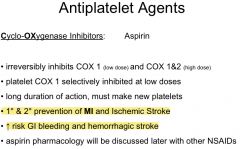
|
|
|
Clopidogrel
prasugrel ticagrelor |
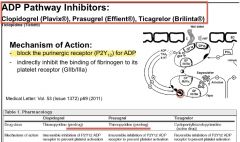
ADP pathway inhibitors
Indication: heart attack and stroke. |
|
|
Abciximab
|
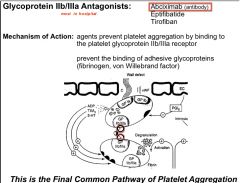
GP2b/3a antagonists
|
|
|
Dipyridamole
|
PDE/Adenosine inhibitor
Dipyridamole inhibits the phosphodiesterase enzymes that normally break down cAMP (increasing cellular cAMP levels and blocking the platelet response to ADP). Dipyridamole inhibits the cellular reuptake of adenosine into platelets, red blood cells and endothelial cells leading to increased extracellular concentrations of adenosine. both mechanism increase platelet cAMP, which inhibits aggregation and produces vasodilation. |
|
|
phytonadione
|
vitamine K1
|
|
|
de-fero-xamine
|
It has medical applications as a chelating agent used to remove excess iron from the body
|
|
|
De-fera-sirox
|
oral chelating agen used for chronic iron overload
|
|
|
vitamine B12
|
Cyanocobalamin
|
|
|
Erythropoietin (EPO)
-func -preparation |
-Erythropoietic GF
-Epoetin Alfa and Darbepoetin[is a synthetic form of erythropoietin. It stimulates erythropoiesis (increases red blood cell levels) and is used to treat anemia] |
|
|
GMCSF(granulocyte/macrophage colony stimulating factor)
fuc preparations |
-stimulates proliferation , differentiation and function of neutrophils , monocytes and eosinophils
-Sargramostim:a recombinant granulocyte macrophage colony-stimulating factor (GM-CSF) that functions as an immunostimulator |
|
|
GCSF (granulocyte colony stimulating factor)
-Func -preparations |
-stimulate neutrophiles proliferation and differentiation only
-filgrastim and pegfilgrastim[ a PEGylated form of the recombinant human GCSF analog filgrastim. It serves to stimulate the level of white blood cells (neutrophils)] |
|
|
Interleukin 11
-fun -preparations |
-stimulate proliferation of platelets
-oprelvekin [is recombinant interleukin eleven (IL-11), a thrombopoietic growth factor that directly stimulates the proliferation of hematopoietic stem cells and megakaryocyte progenitor cells and induces megakaryocyte maturation resulting in increased platelet production.] |

